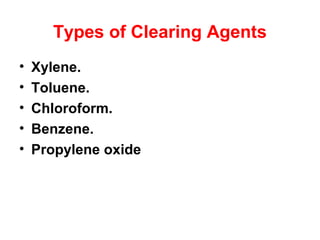Preparation of histological slide
- 2. ŌĆó Histology is the study of tissues and how these tissues are arranged into organs ŌĆó Histo in Greek means tissue or web ŌĆó Tissues consist of cells and extra cellular matrix ŌĆó The function of the tissue depends on the interaction between cells and extracellular matrix. ŌĆó The small size of cells and matrix content make the study of tissues dependent on microscope and other advances in biological techniques
- 3. TISSUE PREPARATION ŌĆó The most widely used method of studying tissues is using histological slides. ŌĆó The tissue in the slide must reflect the actual nature of the tissue in the body ŌĆó To insure that, tissues to be studied must pass through a series of steps before examination ŌĆó These steps are in sequential order ŌĆó Fixation is a complex series of chemical events that differ for the different groups of substance found in tissues.
- 4. TISSUE FIXATION Aim of Fixation: 1- To prevent autolysis and bacterial attack. 2- To fix the tissues so they will not change their volume and shape during processing. 3- To prepare tissue and leave it in a condition which allow clear staining of sections. 4- To leave tissue as close as their living state as possible, and no small molecules should be lost. ŌĆóFixation is a reaction between the fixative and proteins in the specimen which form a gel, so keeping every thing as their in vivo relation to each
- 5. Types of Fixative ŌĆó Acetic acid ŌĆó Formaldehyde 10% ŌĆó Ethanol ŌĆó Glutaraldehyde ŌĆó Methanol ŌĆó Picric acid ŌĆó Osmic acid (Osmium tetroxide)
- 6. TISSUE PROCESSING ŌĆó Aim: Is to embed the tissue in a solid medium firm enough to support the tissue and give it sufficient rigidity to enable thin sections to be cut , and yet soft enough not to damage the knife or tissue. ŌĆó Stages of processing: 1.Dehydration. 2- Clearing. 3- Embedding.
- 7. Dehydration ŌĆó To remove fixative and water from the tissue and replace them with dehydrating fluid. ŌĆó Delicate specimens are dehydrated in a graded ethanol series from water through 10%-20%-50%-95%-100% ethanol to minimize tissue distortion from diffusion currents. ŌĆó In the paraffin method, dehydration from aqueous fixatives is usually initiated in 60%- 70% ethanol, progressing through 90%-95% ethanol, absolute ethanol before proceeding to the clearing stage.
- 8. Types of dehydrating agents ŌĆó Ethanol ŌĆó Methanol ŌĆó Acetone ŌĆó Tissues may be held and stored indefinitely in 70% ethanol without harm
- 9. Clearing ŌĆó Replacing the dehydrating fluid with a fluid that is totally miscible with both the dehydrating fluid and the embedding medium. ŌĆó Choice of a clearing agent depends upon many factors
- 10. Types of Clearing Agents ŌĆó Xylene. ŌĆó Toluene. ŌĆó Chloroform. ŌĆó Benzene. ŌĆó Propylene oxide
- 11. Embedding ŌĆó Is the process by which tissues are surrounded by a medium such as agar, gelatin, or wax which when solidified will provide sufficient external support during sectioning. ŌĆó A substances added alone or in combination to the wax to: Improve ribboning. Increase hardness. Decrease melting point Improve adhesion between specimen and wax
- 12. Embedding Moulds A. paper boat mould B. metal boat mould C. Dimmock embedding mould D. Peel-a-way disposable mould E. Base mould used with embedding ring ( F) or cassette bases (G)
- 13. CUTTING ŌĆó using the microtome
- 14. ŌĆó A microtome is a mechanical instrument used to cut biological specimens into very thin sections for microscopic examination. ŌĆó Most microtomes use a steel blade and are used to prepare sections of animal or plant tissues for histology.
- 15. Microtome knives ŌĆó STEEL KNIVES ŌĆó NON-CORROSIVE KNIVES FOR CRYOSTATS ŌĆó DISPOSABLE METAL BLADES ŌĆó GLASS KNIVES ŌĆó DIAMOND KNIVES
- 16. STAINING
- 17. Hematoxylin and Eosin (H & E) ŌĆó H & E is a charge-based, general purpose stain. ŌĆó Hematoxylin stains acidic molecules shades of blue. ŌĆó Eosin stains basic materials shades of red, pink and orange. ŌĆó H & E stains are universally used for routine histological examination of tissue sections.
- 18. Staining Procedure ŌĆó Deparaffinize and hydrate to water ŌĆó If sections are Zenker-fixed, remove the mercuric chloride crystals with iodine and clear with sodium thiosulphate (hypo) ŌĆó Mayer's hematoxylin for 15 minutes ŌĆó Counterstain with eosin from 15 seconds to 2 minutes depending on the age of the eosin, and the depth of the counterstain desired ŌĆó Dehydrate in 95% and absolute alcohols, two changes of 2 minutes each or until excess eosin is removed ŌĆó Clear in xylene, two changes of 2 minutes each ŌĆó Mount in Permount or Histoclad
- 19. Staining machine
- 20. ŌĆó Basic dyes stain: Heterochromatin Nucleic acids Ribosomes Cartilage ŌĆó Acidic dyes stain: Filaments Mitochondria Collagen Muscle fibers
- 21. Additional Dyes ŌĆó Many tissue components can not be stained with (Hematoxylene and Eosin). ŌĆó Other dyes are used to specifically stain certain tissue components Resorcin-Fuchsin for elastic fibers Silver stain for reticular fibers and basement membrane Periodic-Acid Schiff (PAS) Reaction for CHO






















